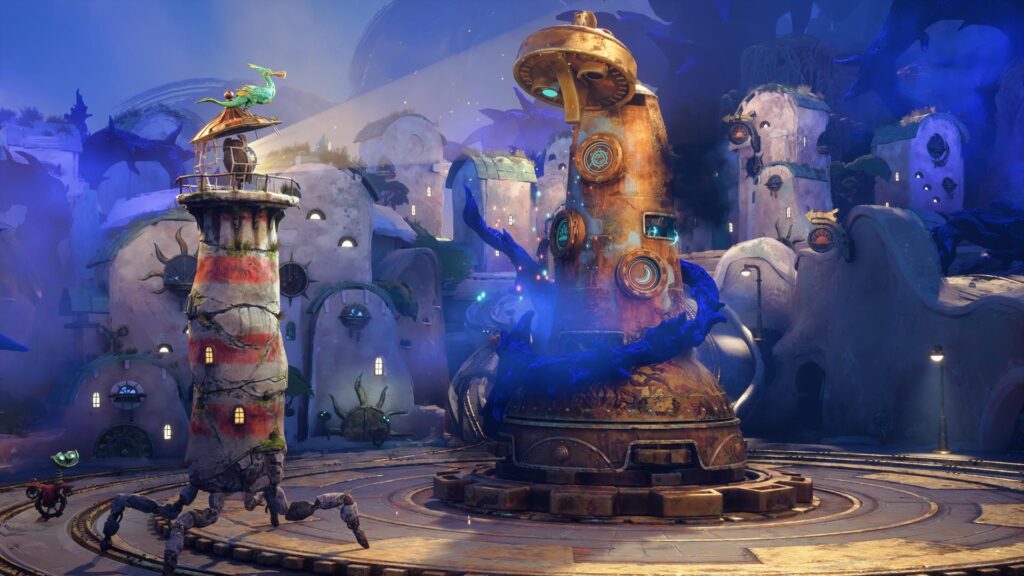To say this year has been chock-full of bizarre premises would be an understatement, especially in the indie space. However, even with all the unorthodox mechanics, leave it to Double Fine Productions to prove it can still deliver a truly unique scenario unlike anything else out there. An adventure title told without any words, starring a sentient lighthouse that wanders around a seemingly ruined island with sentient wonders of the mechanical and biological kind, where your only companion is a seabird? Suffice it to say, I was in, but still skeptical. After all, as intriguing as premises like Headlander and RAD have been in the past (both also directed by Lee Petty), their execution failed to really live up to the same.
That’s not quite the case in Keeper, thankfully, and even if it isn’t exactly breaking the mold as far as titles in the genre go, there’s still an incredibly vibrant and mysterious world to explore with some fun and unorthodox puzzles. And that’s without factoring in the visuals and music, with art direction channelling that signature Double Fine feel while still feeling unique.
The story starts out in a straightforward enough fashion. A flock of seabirds is pursued by a mysterious swarm, and one of them is separated, dropping down to the island and settling on a dilapidated lighthouse. Just when it seems the end is near, the latter springs to life, flashing its light and dispersing the swarm, or at least causing it to retreat. From that moment on, the two travel together, and really, things only get weirder from there.
“It’s to Double Fine’s credit that each of these entities is brimming with personality, and even if you don’t directly interact with many of them, they still play a part in the puzzles.”
But the lighthouse is about as baffled by its sudden sentience as we are. It groans and creaks from its stationary position, crumbing in a heap before inevitably gaining legs and the gift of movement…before unceremoniously tipping over again due to its sheer heft. Even as it learns balance, that heft is always apparent throughout, whether it’s dashing quickly or skulking through dark caverns. In a sense, it’s almost representative of the lighthouse’s mood. It can take a bit of getting used to, especially while moving around and orienting the light, but it feels natural after a point.
Nevertheless, it’s the mysteries of Keeper that will push you to progress forward. Why did the lighthouse suddenly awaken? What is this mysterious power that allows it to manipulate the environment? What is this island, and who are its denizens? How influential was the seabird in its awakening, and just what is that giant beacon on the mountaintop that the lighthouse is seemingly compelling towards? What exactly is the swarm, and why are they so incessantly chasing after the seabird? What happened to the rest of the flock? Those are only a handful of questions that come to mind, and Double Fine is more than happy to throw a few more while keeping you guessing.
Because it’s a wordless narrative, you’ll have to piece things together on your own…or not, if simply barreling through environments and taking in the world is more to your liking. Keeper is as much of a vibe as it is a narrative, thanks to its surreal environment. There’s a post-apocalyptic element to the island, almost as if its prior civilisation was long since wiped out, but then you encounter some of the stranger beings that inhabit it. The rocks that are also wandering around on four legs. The sentient tree that really needs those three blue orbs to let you through. The door looks just absolutely depressed because its symbols are misaligned, and it’s represented by a single eye.
It’s to Double Fine’s credit that each of these entities is brimming with personality, and even if you don’t directly interact with many of them, they still play a part in the puzzles. Your primary functions as a lighthouse, at least initially, include walking around, dashing through obstacles and shining a light (which can be focused to occasionally burn through certain parts of the environment, among other things). The seabird also helps out, whether it’s clasping onto levers and turning them, retrieving items, shaking fruit from trees or pulling objects. It’s all simple enough and easy to grasp, especially from the outset, until you remember that shining a light on those sentient rocks causes them to suddenly drop down, breaking anything beneath them, which comes in handy for retrieving an object in the environment.
“That variety is obvious in the environments as well, which range from extensive lush greenery to shadowy catacombs where a dark presence resides in the island’s underbelly for some unknown purpose.”
Eventually, you’ll manipulate other searchlights to clear a path for the lighthouse and even shift between the realms of the dead and living (at least as I understand it) to turn the seabird into a spirit that phases through walls, restoring its corporeal state to actually manipulate the switches. It’s only a teaser for some of the truly bizarre mechanics to come, but it also highlights Keeper’s confidence in its gameplay variety. Even as simple as it can feel at times with all the mulling about from one point to the next, and even if these puzzles aren’t especially difficult, they still feel unique and, more importantly, don’t overstay their welcome.
That variety is obvious in the environments as well, which range from extensive lush greenery to shadowy catacombs where a dark presence resides in the island’s underbelly for some unknown purpose. Even if some elements will creep certain players out (caution to those suffering from arachnophobia, if it wasn’t obvious by now why), Keeper is simply awash in incredible details and surreal findings. This is further aided by the music, which alternates between upbeat and whimsical to dire and foreboding depending on the location. And even with the lack of spoken dialogue, the animation work is strong enough that you can actually feel the camaraderie between the lighthouse and the seabird developing in real time.
Of course, it’s worth bringing up performance and optimisation on PC. An Intel Core i5-11400, 32 GB RAM and an RTX 4060 – well above the minimum requirements, but well below the recommended. Despite this, I still managed to run it in 1080p with all graphics settings at High and with DLAA enabled. Frame Generation is responsible for ensuring the frame rate stays at a relatively consistent 60 frames per second throughout, with minimal drops. And that’s saying something, given the sheer amount of detail, lighting, shadows, and effects present throughout, even with this animated art style.
“Keeper doesn’t try to overwhelm you with its environments and storytelling so much as ease you in, offering some incredible environments, gorgeous visuals and fantastic music along the way.”
With so many incredible games launching this season, not to mention the other two major offerings that Microsoft is publishing this month alone, Keeper is definitely at risk of being swept under the rug. The relatively modest $30 price belies an experience that isn’t too long, and which can sometimes feel a bit too linear at points (though you occasionally have some freedom).
However, for those who stick with it, there’s a sweeping narrative to explore, one that goes beyond your average quest to save the world, focusing on unlikely friendships against bizarre odds. Keeper doesn’t try to overwhelm you with its environments and storytelling so much as ease you in, offering some incredible environments, gorgeous visuals and fantastic music along the way. Again, it’s not exactly pushing the adventure puzzle genre forward, but in terms of execution, especially when it comes to Double Fine titles, it’s a success and then some.
This game was reviewed on PC.





